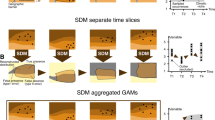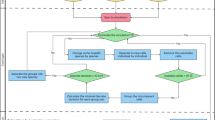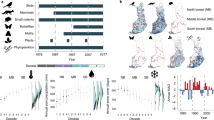Abstract
Global climates are changing rapidly, with unexpected consequences1. Because elements of biodiversity respond intimately to climate as an important driving force of distributional limitation2, distributional shifts and biodiversity losses are expected3,4. Nevertheless, in spite of modelling efforts focused on single species2 or entire ecosystems5, a few preliminary surveys of fauna-wide effects6,7, and evidence of climate change-mediated shifts in several species8,9, the likely effects of climate change on species' distributions remain little known, and fauna-wide or community-level effects are almost completely unexplored6. Here, using a genetic algorithm and museum specimen occurrence data, we develop ecological niche models for 1,870 species occurring in Mexico and project them onto two climate surfaces modelled for 2055. Although extinctions and drastic range reductions are predicted to be relatively few, species turnover in some local communities is predicted to be high (>40% of species), suggesting that severe ecological perturbations may result.
This is a preview of subscription content, access via your institution
Access options
Subscribe to this journal
Receive 51 print issues and online access
$199.00 per year
only $3.90 per issue
Buy this article
- Purchase on Springer Link
- Instant access to full article PDF
Prices may be subject to local taxes which are calculated during checkout



Similar content being viewed by others
References
Houghton, J. T. et al. (eds) IPCC Third Assessment Report: Climate Change 2001 (Cambridge Univ. Press, Cambridge, 2001).
Johnston, K. M. & Schmitz, O. J. Wildlife and climate change: Assessing the sensitivity of selected species to simulated doubling of atmospheric CO2 . Glob. Change Biol. 3, 531–544 (1997).
Dobson, A., Jolly, A. & Rubenstein, D. The greenhouse effect and biological diversity. Trends Ecol. Evol. 4, 64–68 (1989).
Chapin, F. S. I. et al. Consequences of changing biodiversity. Nature 405, 234–242 (2000).
Woodward, F. I., Lomas, M. R. & Betts, R. A. Vegetation-climate feedback in a greenhouse world. Phil. Trans. R. Soc. Lond. B 353, 29–39 (1998).
Sala, O. E. et al. Global biodiversity scenarios for the year 2100. Science 287, 1770–1773 (2000).
Price, J. Modeling the potential impacts of climate change on the summer distributions of Massachusetts passerines. Birds Obs. 28, 224–230 (2000).
Visser, M. E., van Noordwijk, A. J., Tinbergen, J. M. & Lessells, C. M. Warmer springs lead to mistimed reproduction in great tits (Parus major). Proc. R. Soc. Lond. B 265, 1867–1870 (1998).
Parmesan, C. Climate and species' range. Nature 382, 765–766 (1996).
Soberon, J. Linking biodiversity information sources. Trends Ecol. Evol. 14, 291 (1999).
Peterson, A. T. et al. Effects of global climate change on geographic distributions of Mexican Cracidae. Ecol. Model. 144, 21–30 (2001).
Peterson, A. T. Predicting species' geographic distributions based on ecological niche modeling. Condor 103, 599–605 (2001).
Koopowitz, H., Thornhill, A. D. & Andersen, M. A general stochastic model for the prediction of biodiversity losses based on habitat conversion. Conserv. Biol. 8, 452–438 (1994).
Davis, A J., Jenkinson, L. S., Lawton, J. H., Shorrocks, B. & Wood, S. Making mistakes when predicting shifts in species range in response to global warming. Nature 391, 783–786 (1998).
Peterson, A. T. & Vieglais, D. A. Predicting species invasions using ecological niche modeling. BioScience 51, 363–371 (2001).
Sánchez-Cordero, V. & Martínez-Meyer, E. Museum specimen data predict crop damage by tropical rodents. Proc. Natl Acad. Sci. USA 97, 7074–7077 (2000).
Peterson, A. T., Stockwell, D. R. B. & Kluza, D. A. in Predicting Species Occurrences: Issues of Scale and Accuracy (ed. Scott, J. M.) (Island, Washington DC, in the press).
Stockwell, D. R. B. & Peters, D. P. The GARP modelling system: Problems and solutions to automated spatial prediction. Int. J. Geograph. Inform. Systems 13, 143–158 (1999).
Peterson, A. T. & Navarro-Sigüenza, A. G. Alternate species concepts as bases for determining priority conservation areas. Conserv. Biol. 13, 427–431 (1999).
Peterson, A. T., Navarro-Sigüenza, A. G. & Benítez-Diaz, H. The need for continued scientific collecting: A geographic analysis of Mexican bird specimens. Ibis 140, 288–294 (1998).
Peterson, A. T., Soberón, J. & Sánchez-Cordero, V. Conservatism of ecological niches in evolutionary time. Science 285, 1265–1267 (1999).
Llorente-Bousquets, J., Luis, A. & Vargas, I. Papilionidae y Pieridae de México: Distribución Geográfica e Ilustración (Universidad Nacional Autónoma de México, Mexico City, 1997).
Tobler, W. R. Smooth pycnophylactic interpolation of geographic regions. J. Am. Stat. Ass. 74, 519–530 (1979).
Carson, D. J. Climate modelling: achievements and prospects. Q. J. R. Meteorol. Soc. 125, 1–27 (1999).
Holt, R. D. & Gaines, M. S. Analysis of adaptation in heterogeneous landscapes: implications for the evolution of fundamental niches. Evol. Ecol. 6, 433–447 (1992).
Grinnell, J. Field tests of theories concerning distributional control. Am. Nat. 51, 115–128 (1917).
MacArthur, R. Geographical Ecology (Princeton Univ. Press, Princeton, 1972).
Austin, M. P., Nicholls, A. O. & Margules, C. R. Measurement of the realized qualitative niche: Environmental niches of five Eucalyptus species. Ecol. Monogr. 60, 161–177 (1990).
Peterson, A. T., Ball, L. G. & Cohoon, K. C. Predicting distributions of tropical birds. Ibis 144, e27–e32 (2002).
Acknowledgements
We thank A. G. Navarro-Sigüenza, J. E. Llorente-Bousquets, A. M. Luis, I. Vargas and L. Oniate for assembling distributional data, C. Thomas for help and advice, and E. Martínez-Meyer, G. Jiménez-Casas, S. Egbert and K. P. Price for collaboration. This research was supported by the US National Science Foundation, and grants from CONACyT and DGAPA to J. Soberón and V. Sánchez-Cordero.
Author information
Authors and Affiliations
Corresponding author
Ethics declarations
Competing interests
The authors declare that they have no competing financial interests
Rights and permissions
About this article
Cite this article
Peterson, A., Ortega-Huerta, M., Bartley, J. et al. Future projections for Mexican faunas under global climate change scenarios. Nature 416, 626–629 (2002). https://doi.org/10.1038/416626a
Received:
Accepted:
Issue Date:
DOI: https://doi.org/10.1038/416626a
This article is cited by
-
Revealing the long-term trend of the global-scale Ginkgo biloba distribution and the impact of future climate change based on the ensemble modeling
Biodiversity and Conservation (2023)
-
Current and future distribution pattern of Cochlospermum planchonii and Cochlospermum tinctorium in Benin (West Africa), in response to climate change scenario
Modeling Earth Systems and Environment (2022)
-
Rapid range expansion predicted for the Common Grackle (Quiscalus quiscula) in the near future under climate change scenarios
Avian Research (2021)
-
Climate warming affects spatio-temporal biodiversity patterns of a highly vulnerable Neotropical avifauna
Climatic Change (2021)
-
Austral Yungas under future climate and land-use changes scenarios: the importance of protected areas for long-term amphibian conservation
Biodiversity and Conservation (2021)
Comments
By submitting a comment you agree to abide by our Terms and Community Guidelines. If you find something abusive or that does not comply with our terms or guidelines please flag it as inappropriate.



